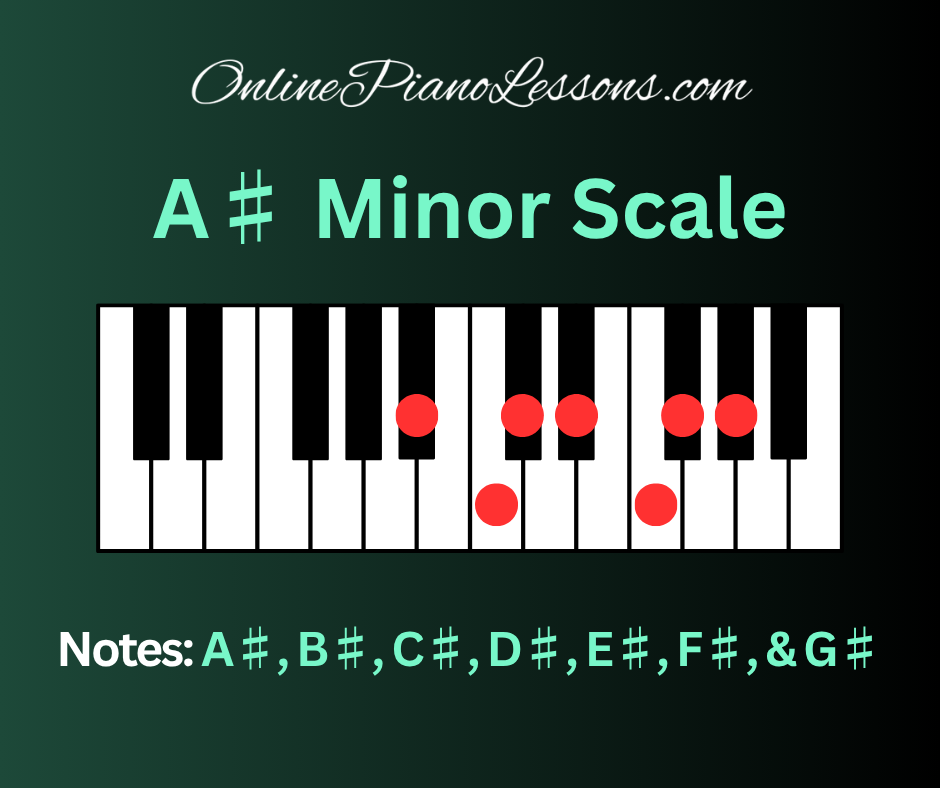
The A sharp minor scale (often written A♯ minor scale) is the natural minor scale built on the pitch A♯. Following the natural minor pattern (whole–half–whole–whole–half–whole–whole), the scale degrees are spelled: A♯, B♯, C♯, D♯, E♯, F♯, G♯, and then back to A♯.
On the piano this key is enharmonically identical to B♭ minor, meaning the same physical keys are depressed, but the theoretical spelling uses sharps and sometimes double-sharp logic to preserve one-letter-per-degree notation. Learning the A sharp minor scale gives pianists fluency both in keyboard technique and in theoretical spelling conventions.
Quick Preview: The A sharp minor scale (A♯, B♯, C♯, D♯, E♯, F♯, G♯) is a theoretical and sharp-based minor key that’s enharmonically equivalent to B flat minor on the piano. This definitive guide explains what the A sharp minor scale is, how to find and play it on the piano, its chords and modes, key signature and notation quirks, practical fingering and exercises, and why understanding A♯ minor deepens your knowledge of enharmonic relationships and advanced harmony.
A Sharp Minor Key Signature and Notation
If you were to write A♯ minor as a key signature, you would derive it as the relative minor of C♯ major (which has seven sharps). That means the A♯ minor scale’s key signature would include seven sharps: F♯, C♯, G♯, D♯, A♯, E♯, and B♯. Practically speaking, many engravers and composers prefer to use the enharmonic B♭ minor (five flats) for readability. Nevertheless, the A♯ minor scale has correct theoretical status: its spelled notes are A♯, B♯, C♯, D♯, E♯, F♯, and G♯. For students of advanced harmony and analysis, practicing the A♯ minor scale trains the eye to handle sharp-based spellings and clarifies modulation paths in sharp-heavy contexts.
How to Find A♯ Minor Scale on the Piano
On the piano, playing the A♯ minor scale is physically identical to playing B♭ minor. Here’s a quick way to find it:
- Locate A♯ (the black key immediately to the right of A).
- Ascend: A♯ (black) → B♯ (white key C) → C♯ (black) → D♯ (black) → E♯ (white key F) → F♯ (black) → G♯ (black) → A♯ (octave).
- Descend using the reverse order.
Although you press familiar white and black keys, the spelled names (B♯ and E♯) remind you that the A♯ minor scale is being treated as a sharp-based minor key. When reading scores or writing music in sharp-dominant contexts, keeping this spelling discipline matters for correct harmonic interpretation.
The Sound and Character of A♯ Minor
On the piano, the A sharp minor scale sounds exactly like B flat minor: dark, brooding, and rich in minor-mode color. Composers and performers associate minor keys with introspective, melancholic, or dramatic affects, and the A♯ minor scale is no exception. While the aural character is identical to its enharmonic counterpart, the theoretical label A♯ minor can imply different harmonic expectations in analysis—especially when modulations pass through multiple sharp keys and maintaining consistent letter names clarifies voice-leading.
Natural, Harmonic, and Melodic Variants
Like any minor key, A♯ minor can appear in three common forms:
- A♯ natural minor: A♯, B♯, C♯, D♯, E♯, F♯, G♯.
- A♯ harmonic minor: raise the 7th degree (G♯ → G𝄪) giving A♯, B♯, C♯, D♯, E♯, F♯, G𝄪. This introduces the leading tone (G𝄪) that strongly resolves to A♯.
- A♯ melodic minor: ascending, raise 6th and 7th (F♯→F𝄪 and G♯→G𝄪): A♯, B♯, C♯, D♯, E♯, F𝄪, G𝄪; descending revert to natural minor form.
On the piano these alterations equate to familiar black/white key patterns, but the double-sharp notation (G𝄪, F𝄪) appears in theoretical contexts. Understanding these variants helps pianists improvise, compose, and interpret period-accurate or analytically accurate passages in sharp keys.
Chords and Harmony in the A Sharp Minor Scale
Building diatonic triads from the A♯ minor scale yields the familiar harmonic palette of any minor key, spelled using sharp notation:
- i — A♯ minor (A♯–C♯–E♯)
- ii° — B♯ diminished (B♯–D♯–F♯) or often iiø in practice
- III — C♯ major (C♯–E♯–G♯)
- iv — D♯ minor (D♯–F♯–A♯)
- v — E♯ minor (E♯–G♯–B♯) (often made major as V by raising B♯→B𝄪?)
- VI — F♯ major (F♯–A♯–C♯)
- VII — G♯ major (G♯–B♯–D♯)
For harmonic variety, composers employ the harmonic minor’s leading tone (G𝄪) to create a dominant V (E♯ major with G𝄪 as the third) that resolves strongly to A♯. Pianists should be comfortable playing these chord shapes and their inversions on the piano, even when the notation looks sharp-heavy.
Melodic and Technical Fingering for Piano
When practicing the A♯ minor scale on piano, use fingerings that match your physical comfort and typical minor-key patterns. A practical one-octave fingering:
- Right hand: 1–2–3–1–2–3–4–5
- Left hand: 5–4–3–2–1–3–2–1
For two-octave scales and arpeggios, adapt fingerings to keep thumb crossings smooth at the white-key positions (B♯ = C, E♯ = F). Practicing scales hands separately, then together, gradually increasing metronome tempo builds evenness and control. Because A♯ minor maps to B♭ minor physically, many pianists will feel immediately comfortable if they already know B♭ minor; the added task is reinforcing theoretical spelling for analysis and notation fluency.
Modes, Relative Minor, and Enharmonic Equivalents
The A♯ minor scale’s relative major is C♯ major (seven sharps). Its enharmonic equivalent is B♭ minor (B♭, C, D♭, E♭, F, G♭, A♭). When analyzing modulation or harmonic strategy, deciding whether to think in A♯ minor or B♭ minor depends on the tonal context. If the music is moving through sharp-dominant regions (e.g., C♯ major → A♯ minor), using A♯ minor keeps letter names consistent and reveals clearer voice-leading.
Exploring modes (A♯ Dorian, A♯ Phrygian, etc.) derived from A♯ minor’s parent scales can give pianists additional melodic and improvisational vocabulary, particularly in jazz or contemporary classical contexts.
Practical Uses and When You’ll Encounter A♯ Minor
In practice, true A♯ minor notation is rare—composers usually opt for B♭ minor because it’s easier to read. However, you may encounter A♯ minor in theoretical exercises, analytical discussions, or in compositions that intentionally preserve sharp-based spellings for clarity when moving through complex key relationships. For pianists studying harmony, counterpoint, or orchestration, understanding A♯ minor is valuable: it trains your notation literacy and prepares you for editing, arranging, and transposition work.
Practice Tips for Mastery
- Treat A♯ minor as B♭ minor physically on the piano but spell the notes in A♯ notation when writing or analyzing.
- Practice natural, harmonic, and melodic minor forms to internalize their unique melodic pulls.
- Work through diatonic chord inversions and common progressions (i–iv–V–i, ii°–V–i) in A♯ minor on the piano.
- Sight-read examples written in A♯ notation to build reading fluency with B♯ and E♯.
- Compose short motifs in A♯ minor to explore voice-leading and enharmonic implications.
Conclusion: A Sharp Minor Scale
The A sharp minor scale is a theoretically elegant but practically uncommon minor key on the piano. While physically identical to B♭ minor, its sharp-based notation (A♯, B♯, C♯, D♯, E♯, F♯, G♯) matters in analysis, modulation, and contexts that favor sharp spellings. For pianists, learning the A♯ minor scale builds not only technical skill but also analytical depth—helpful for composition, transcription, and advanced theory study.
FAQ
What notes make up the A sharp minor scale?
The A♯ minor scale is spelled A♯, B♯, C♯, D♯, E♯, F♯, and G♯.
Is A♯ minor the same as B♭ minor on the piano?
Yes — A♯ minor and B♭ minor are enharmonic equivalents: they sound the same on the piano but are written differently.
Why is A♯ minor rarely used in scores?
Because its notation requires many sharps (and occasionally double-sharps) making it harder to read; composers typically use B♭ minor for clarity.
How should I practice the A♯ minor scale on piano?
Practice it as you would B♭ minor physically, then spell and analyze passages using A♯ notation to build theoretical fluency.
When might I need to know A♯ minor?
You’ll encounter it in theoretical work, in analysis of sharp-based modulatory passages, and in contexts where maintaining consistent letter names simplifies voice-leading and harmonic interpretation.





 Hi, I'm Thomas, Pianist Composer,
Hi, I'm Thomas, Pianist Composer,  I love playing piano, creating new melodies and songs, and further developing my online piano course and making updates/additions to my site OnlinePianoLessons.com!
I love playing piano, creating new melodies and songs, and further developing my online piano course and making updates/additions to my site OnlinePianoLessons.com!  Now that is what I call fun!
Now that is what I call fun!





